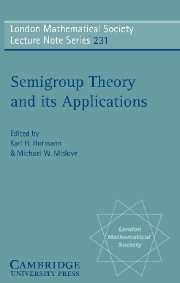 Semigroup Theory and its Applications
Semigroup Theory and its Applications Book contents
- Frontmatter
- Contents
- Foreword
- Reminiscences of a friendship
- I Historical Perspective
- II Current Trends
- III New Directions
- Maps implicit in the Jordan-Hölder theorem
- Finite semigroups as categories, ordered semigroups or compact semigroups
- Principles underlying the degeneracy of models of the untyped lambda calculus
Special involutions
Published online by Cambridge University Press: 05 April 2013
- Frontmatter
- Contents
- Foreword
- Reminiscences of a friendship
- I Historical Perspective
- II Current Trends
- III New Directions
- Maps implicit in the Jordan-Hölder theorem
- Finite semigroups as categories, ordered semigroups or compact semigroups
- Principles underlying the degeneracy of models of the untyped lambda calculus
Summary
This article takes the form of a survey of results concerning a particular kind of involution — called, for want of a better term, ‘special’ — on a semigroup or ring. Most of the material is based on recent joint work by David Easdown (Sydney) and the author ([4], [5]); the remainder, comprising Section 3, is taken from [7].
Introduction
By an involution on a semigroup S we mean a mapping * : S → S, x ↦ x*, such that
Note that the second requirement ensures that * is a permutation of S further, if S is commutative then the identity permutation of S is an involution. An involution on a ring R is a mapping * : R → R that is an automorphism of the group (R, +) and an involution on the semigroup (R, ·).
We shall be concerned here with the following type of involution.
Definition. An involution * on a semigroup [ring] S is special if and only if, for every nonempty finite subset T of S,
Although our condition might, at first sight, appear somewhat complicated — and even artificial — it is satisfied frequently and in a variety of natural contexts. First, let us consider some examples.
Example 1. On a group G, inversion (x ↦ x−1) is a special involution.
This is a trivial matter. Let T be a nonempty subset (not necessarily finite) of G, let t be an arbitrary member of T and let u, v ∈ G be such that tt−1 = uv−1. Then u = v.
Example 2. Let S denote the free semigroup on a nonempty set X.
- Type
- Chapter
- Information
- Semigroup Theory and its ApplicationsProceedings of the 1994 Conference Commemorating the Work of Alfred H. Clifford, pp. 157 - 165Publisher: Cambridge University PressPrint publication year: 1996


